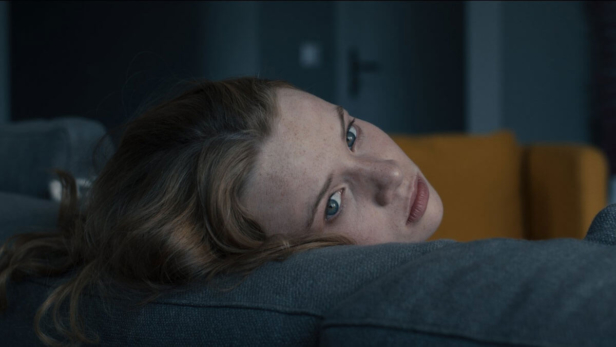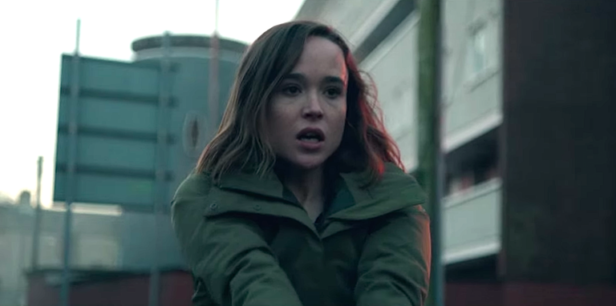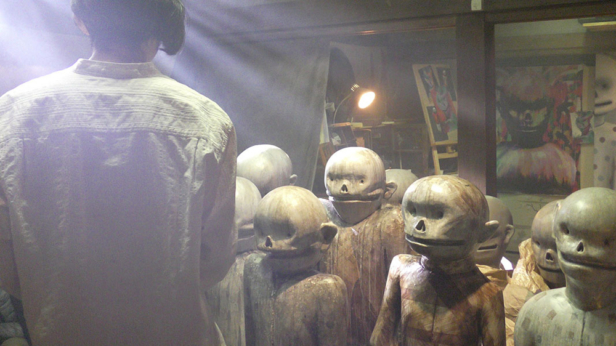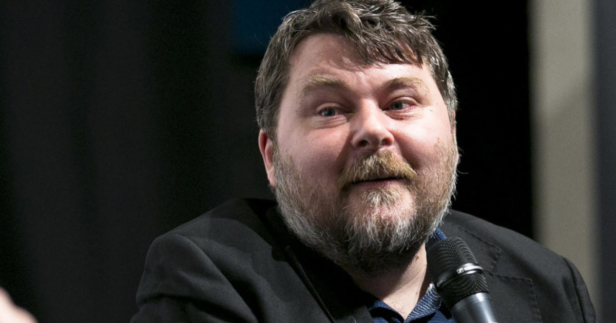The annual Glasgow Film Festival is a haven of genre, not only harbouring FrightFest in GFT1 for two and a half days of the festival’s duration, but also weaving many freaky frights and SF sights into the fabric of its main programme. This comes as no surprise – for genre, combining familiar narrative types with an omnivorous approach to societal tensions and clashing ideologies, offers as good a window on the world as any other kind of cinema, while attracting a highly committed audience. Here are a few of the offerings that SciFiNow managed to catch in Glasgow before and after FrightFest.
Blue My Mind (2017)
It opens with a little red-haired girl on a rocky beach looking out to sea. Later we see that same girl Mia (Luna Wedler), now a teenager, in the new apartment (still visibly under construction) where she has just moved with her parents. And we see her frequently on overpasses and underpasses, with traffic rushing by. In other words, Mia is shown occupying symbolically liminal spaces, even as we watch her undergoing her own transition from childhood to adulthood. For Blue My Mind is a classic rite of passage, in which its physically changing protagonist has her first period and her first sexual encounter, and discovers her independence from a mother and father whose relationship to herself she barely recognises any more.
Like Carrie (1976), Ginger Snaps (2000), When Animals Dream (2014) and Thelma (2017), Lisa Brühlmann’s feature debut figures its young heroine’s coming of age as horror, with Mia’s emergent hybrid form encapsulating the interstitial nature of adolescence itself. After Mia has spontaneously devoured her mother’s pet goldfish, had her toes suddenly fuse together, and seen the skin on her legs bruise and shed, she will end up once more on that rocky beach, with the ocean of adult experience wide open ahead, just waiting for her to dive in.
Blue My Mind is a fishy tail of growing up, presenting all the awkward ickiness of sexual awakening (and the easy susceptibility of young women to male exploitation) with not only disarming frankness but also a lyrical beauty. For here, where genre is used as an expressive metaphor for teen alienation and transformation, Mia’s developing, bleeding body becomes, for her, an object of fascination, disgust and anxiety – and the feminine proves not so much monstrous as self-determining and liberating.
The Cured (2017)
Where most zombie films take place at the beginning or in the middle of an undead outbreak, David Freyne’s feature debut takes place in the aftermath. For, as its very title implies, The Cured concerns the challenges presented by attempts to reintegrate into a raw, ravaged community those who have recovered from their deadly rampage through it. In other words, this film is not so much post-apocalyptic as post-post-apocalyptic – a little like Juan Carlos Fresnadillo’s 28 Weeks Later, only with the key difference that the setting has shifted from London, England to Dublln, Ireland.
This film’s equivalent of the zombifying ‘rage virus’, a rapidly transmissible disease which reduces its victims to a furious, cannibalistic pack mentality, is known as the ‘Maze Virus’, a name evocative of the Maze Prison in Northern Ireland where IRA and Ulster Loyalist paramilitaries were once detained. Indeed The Cured is a barely concealed allegory of a nation having to live with anger, civil division and internecine killings which, though mostly now confined to the past, have left deep scars and the constant possibility of another breakout. As one of the cured, Senan (Sam Keeley), struggles to come to terms with the outrages he has committed against others and to rebuild a new life with his widowed sister-in-law (Ellen Page) and her young son, another (the chillingly creepy Tom Vaughan-Lawlor) seeks opportunistically to reorganise the ostracised ‘cured’ and to rekindle past tensions for his own political gain.
The parallels with the Troubles are hard to miss, from the ubiquitous messages (painted or posted on walls) warning of sectarian dangers within, to the militarisation of policing, to the deadly terror campaigns conducted through molotov cocktails and pipe bombs, to the blink-and-you’ll-miss-it glimpse of one persistently uncured prisoner conducting a ‘dirty protest‘ by smearing faeces on a cell wall. Coming at a moment when the Good Friday Agreement, and the fragile peace in Northern Ireland that it enshrines, are at risk of being unravelled by Brexit negotiations, The Cured is a timely exploration of tinderbox issues through the prism of a familiar genre. It also portrays a nation in constant confrontation with its own recent, bloody history.
Vampire Clay (2017)
“I don’t want to lose my individuality to convention.”
These words, uttered by one of five students in a new rural prep school for Tokyo’s hyper-competitive fine arts courses, cuts to the heart of Soichi Umezawa’s feature debut Vampire Clay (Chi o sû nendo). For while the film is certainly built, as its very title signals, upon familiar horror conventions (not only vampires but also the slasher, demonology and even, towards the end, the city-destroying kaiju), Umezawa remoulds all of these into something peculiar and highly individual – ensuring that Vampire Clay, concerned as it is with the transformative potential of the plastic arts, is also a film about itself and its own fictile forms.
As these five wannabe sculptors bicker and fret about their chances of getting into a prestigious Tokyo university, and deal in petty rivalries and little romances, their hapless, bitter teacher Aina (Asuka Kurosawa) questions her own ability to shape her young wards into great artists. Yet when she discovers, bagged and buried in the woods outside, some clay with its own history connected to another artist who had once lived there, she inadvertently unleashes a demonic blood-sucking creature (realised, of course, through claymation) which absorbs – but also embodies and expresses – all the characters’ provincial ambitions to take Tokyo by storm.
Cribbing from countless slash-and-dash flicks (our clay killer likes to stab his prey before grotesquely assimilating them), but also from the stop-motion sections of Eraserhead (1977) and the body horror of David Cronenberg, Vampire Clay brings all kinds of freak to its frights. Sure the performances are a little overplayed (not that this did Nobuhiko Obayashi’s House any harm), and sure the many scenes of flight-and-fight are not as varied as the monster’s Protean form – but this film of eerie earthenware and earthworms-that-turn comes with enough individuality and eccentricity, if not downright idiosyncrasy, to earn itself the sort of appreciation (and, no doubt from some, abhorrent rejection) that typically greets products of outsider art.
Ben Wheatley masterclass
Is there a British filmmaker who better bridges the worlds of the arthouse/festival scene and of gritty, gory genre filmmaking than Ben Wheatley? His delirious J.G. Ballard adaptation High-Rise and his shoot-em-up satire of masculinity Free Fire have both screened at previous Glasgow Film Festivals – and this year he returned to give a master class before a packed theatre.
One might have thought that his feature debut, the domesticated drugs drama Down Terrace, was chiefly inspired by Quentin Tarantino’s fast-talking comedy of the banal, but in fact Wheatley cites the early horror of Sam Raimi and Peter Jackson as the key influences for his own ultra-low budget spirit of “not relying on anybody and doing it yourself outside of the industry.” Figuring that eight days was the longest that he could ask friends to work free, he shot for a week, mostly in the house of co-writer Robin Hill’s parents, and everyone involved was paid later when the film began to see profits. Wheatley recouped his own investment in Down Terrace “only a year ago.” Off the back of that film’s success, production companies were suddenly interested in Wheatley, enabling him to get the PTSD horror Kill List funded after he submitted a screenplay that he wrote in a mere 10 days (but that he labelled ‘Draft 12’ to suggest he had toiled much longer over it).
Wheatley stated that his inspiration for 17th-century alchemical freakout A Field In England came more from “living in Britain” (where “society is only about an inch deep” and “there’s blood everywhere”) than from the folk horror of, say, The Wicker Man, which is often cited alongside it by critics. “They’re all political, the films”, Wheatley insisted, taking to task those who said that the class divisions staged in his High-Rise were “too on the nose”, when their subsequent enactment during the ideological chaos of Brexit has demonstrated that in fact they were not nearly on the nose enough.
Corresponding with ABBA over permission to use their song SOS in High-Rise was, according to long-term fan Wheatley, “the highlight of my career.” Another was working as jobbing director on Doctor Who, in which he happily served a fixed screenplay that allowed for none of his usual improvisational excursions. As he says, “I wanted to do a Doctor Who episode, I didn’t want to do a Ben Wheatley sci-fi film.” For the latter, we can only hope that some canny producer will step in to finance Wheatley’s projected monster-hunting SF Freak Shift – but in the meantime, he has now wrapped his New Year’s drama Colin, You Anus.



